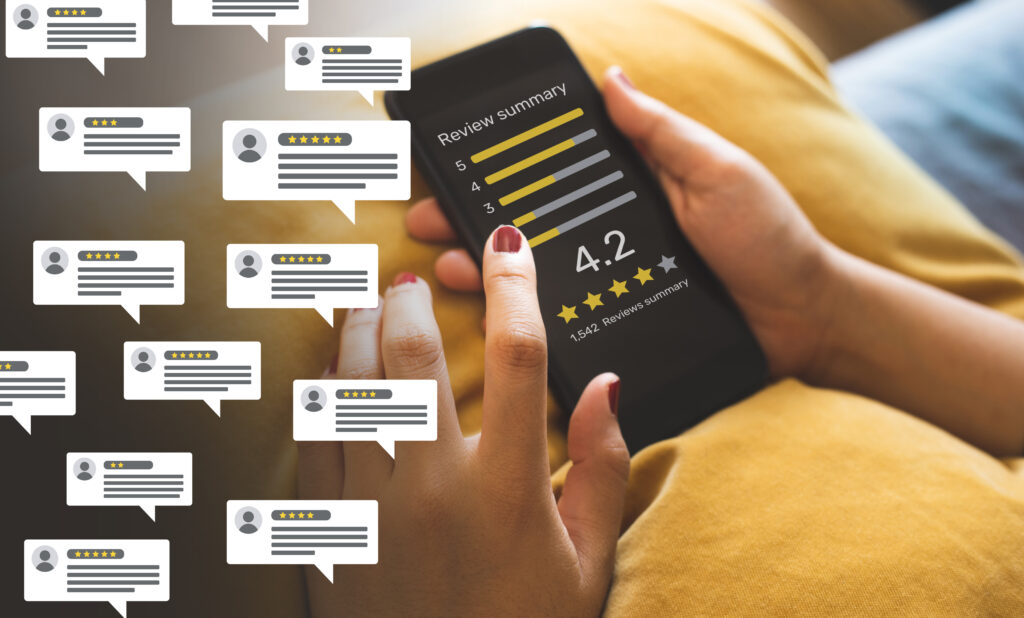Brands are constantly looking for new ways to engage with customers. They try traditional ads, digital promotions, and social media content to win audiences over. However, these channels aren’t always perceived as trustworthy — especially when they stand alone. According to Statista, only 19% of consumers trust advertising on social media. This is significantly lower than content on websites (30%) and search engines (38%).
In the effort to win people over, one format continues to stand above the rest: word of mouth. Personal recommendations, testimonials, and online reviews all have high levels of trust in consumers. Most people don’t believe their friend or parent would steer them wrong, while 91% of 18-34 year-olds trust online reviews.
If your brand wants to tap into the powerful and trustworthy world of online reviews, it needs to be strategic. Look at the latest data to better understand how people read online reviews, what they look for, and the red flags they can easily identify. This will help you build an online presence that is authentic and engaging through your digital testimonials.

1. The Quantity of Your Reviews Matters
There are countless aspects of digital marketing where the quality of the content is more important than the quantity. And while you want high-quality reviews left by your customers, you also need a lot of them.
A 2022 survey by Brightlocal found that 60% of customers care about the number of reviews a business has — an increase from 46% in 2017.
Essentially, the more reviews your business has, the more authentic its rating looks. For example, you can open a car dealership tomorrow and leave a five-star review for the new location. Your review is obviously biased and doesn’t reflect how the general public feels about the business. However, if your dealership acquires 100 reviews over the course of a year and it still has a high rating, the score is more believable.
This doesn’t mean you should ignore the quality of your reviews. Instead, the main takeaway from this data is that it’s worth asking existing customers to leave online reviews because their honest opinions and positive experiences can drive more interest in your brand.
2. Google Is the Most Trusted Review Source
There are dozens of websites where you can promote your business and ask customers to leave reviews. Along with Google, customers can leave reviews on Yelp, the Better Business Bureau, Apple Maps, and even the Yellow Pages. This is where your strategic planning comes in: it’s unrealistic to ask customers to post on multiple sites, so how do you decide which channels you want to promote for online reviews?
Brightlocal also has data for this. In the past 12 months, 81% of survey respondents said they wrote a review on Google. This beat out Yelp (53%) and Facebook (48%). The survey also asked about niche sites like TripAdvisor, Healthgrades, and Angi, but these were all less used and weren’t as useful for automotive dealerships.
Consider where your target audience reads online reviews and channel your efforts to those websites. For example, you might develop an internal campaign to ask customers to leave reviews on Google in order to increase your presence there.
Avoid taking a “spray and pray” approach where you ask customers to leave reviews on multiple websites. Not only will this scatter your efforts and reduce their effectiveness, but it will also create more work for your team that monitors customer comments.
3. Customers Expect You to Respond
If your goal is to improve your traffic and word-of-mouth reputation through online reviews, divide your marketing strategy into two parts. The first part should involve asking existing customers to leave reviews and sending regular reminders through email and text messages. The second part requires follow-up. You need an active team member who reads and responds to reviews to monitor your online presence.
A 2022 survey by ReviewTrackers found that more than half of customers (53%) expect businesses to respond to negative reviews within less than a week. A third of customers expect a response in fewer than three days.
Create a set of best practices within your organization to identify and respond to reviews. This document is just as important as your content style guide or profiles of your target audiences. Here are a few things to consider:
- Always respond to negative and positive reviews within 72 hours. You can create an on-call rotation to handle replies over holidays and long weekends.
- Create a process to go “up the chain” when necessary. If a customer complains online, the marketing team should be able to find out what happened while taking steps to make amends.
- Never delete negative comments unless they are fake or offensive. This creates distrust in your brand and looks like censorship. Trustpilot found 62% of consumers would stop using platforms if they suspected reviews were being censored.
- Develop guidelines for the tone and messaging when responding to comments. Never argue or insult reviewers (it happens), and maintain high levels of professionalism at all times.
- Report spam reviews, fake reviews, and biased reviews (like comments left by disgruntled employees). Google has guidelines for reporting these reviews.
Responding to negative reviews allows you to fix situations that you weren’t aware of. In some cases, the customer might change their review and rating after their problems are fixed. Furthermore, most companies have negative reviews. These actually make their profiles more authentic and help customers with the decision process.
4. It’s Okay If Your Online Reviews Are Short
The team at ReviewTrackers has been following the average length of reviews across multiple platforms. More than a decade ago, in 2010, the average review was 600 characters. In 2022, the average review has shrunk to only 200 characters. Most of the comments and responses to your review requests will be around the length of a Tweet.
This is actually a good thing. If your customers feel less pressure to write long reviews, they are more likely to share their comments. This increases your reviews over time. Similarly, if your audience doesn’t get caught up in one long review, they can read several comments about your brand. They can skim through a dozen reviews highlighting what an awesome business you run.
The quality of the reviews you receive is important, but there are times when you can embrace quantity and benefit from a lot of reviews coming your way.
5. The FTC Is Working to Ban Fake Reviews
As you look to increase your reviews, remember that paying customers for reviews or paying third parties to leave reviews is illegal. According to the Federal Trade Commission (FTC), businesses should avoid offering services or incentives for leaving online reviews (like a free oil change) and cannot stipulate that the review has to be positive in order to review any incentives. Companies also shouldn’t pay people to leave reviews for businesses they have never visited or products they have never tried.
Fake reviews undermine the trustworthiness of digital word-of-mouth marketing. When consumers can no longer trust that comments are genuine and honest, they will stop reading them.
Unfortunately, stopping fake reviews is getting harder by the day. AI tools can produce thousands of reviews each day, and experts are tracking the use of ChatGPT to generate fake comments online.
No one is expecting your business to singlehandedly stop review spam, but you can act ethically and solicit genuine reviews from customers that aren’t paid for or incentivized.

6. Customers Distrust Reviews on Your Website
One of the most common mistakes brands make is soliciting customer feedback through surveys and then sharing positive comments and testimonials on their website. While there is absolutely nothing wrong with sending feedback surveys to customers, you might want to evaluate how effective the reviews you publish on your pages actually are.
First, these comments seem incredibly biased. Very few brands would ever publish scathing reviews about how terrible the company is on its own pages. As a result, when you land on a company’s website, you often see banners that say things like “4.9 stars out of 2,000 reviews!” This is actually a red flag to consumers because of the inflated high score and the source of the data.
Next, consider how your audience is getting to those reviews. You need to bring people to your website before they can see the reviews and act based on the content. Online reviews on Google and Facebook can draw people to your website. However, if you don’t invest in building those reviews, your audience members might be less likely to click through.
Website testimonials can boost your mid-funnel efforts and potentially increase your conversion rate, but you need to be mindful of your limited resources. If you can only generate a certain number of reviews from customers each year, make sure they are going to the right place to maximize their effectiveness and grow your brand.
7. Your Reviews Are Just One Part of Your Buyer Journey
One of the most common themes in the messaging at J&L Marketing is integrating your promotional efforts. Your Google reviews can help your search engine optimation. Your email content and social media posts can increase your word-of-mouth efforts. Each part of your advertising strategy works together as one cohesive unit to maximize effectiveness.
This is also why it isn’t a bad thing that some marketing channels are less trustworthy than others: you can overcome these concerns and build trust through your content.
Consider how different marketing channels can help you grow the number of reviews you have and how your existing reviews can help your marketing channels. Together, you can create mutually beneficial relationships across your advertising team.
For example, a 2023 survey from PowerReviews found 46% of consumers are more willing to click through a marketing email because of the ratings and reviews highlighted. The reviews your customers leave can provide real content to help your email marketers. The same amount (47%) of consumers on social media were moved to action because of reviews.
While your online reviews will mainly serve a top-of-funnel purpose to bring customers to your business, they can also help to engage mid-funnel audiences and to create a final call to action after your customers convert.
Develop an Online Review Strategy Through J&L Marketing
If you have been passively letting online reviews build up for your brand, it’s time to take a more active — and strategic — role in your reputation management. At J&L Marketing, we believe in helping brands out-smart, not out-spend the competition. You can grow your online reviews while sticking to a reasonable budget and then use those reviews to improve your other marketing efforts.
Let’s talk strategy. Contact us today to make your marketing efforts more effective to increase your footprint without necessarily spending more.



